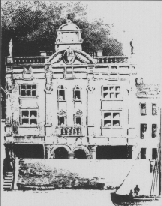


The Dorset Garden Theatre (also known as the Duke's Theatre) was opened in 1671, when the Duke's Players moved there from their previous premises in Lincoln's Inn Fields. The new theatre was built beside the Thames, in Dorset Garden at Whitefriars - the playwright Aphra Behn, who wrote several plays for the Duke's company, lived almost around the corner, in Dorset Street. One advantage of the riverside location was that the more fashionable members of the audience could arrive at the theatre by boat, thus avoiding the dangerous streets of nearby Alsatia, a notorious gathering place for criminals.
The manager of the Duke's Company, Sir William Davenant, was the first to introduce movable scenery. Three or four sets of shutters were arranged in the wings and in the back; these shutters were set into grooves along which they could be quickly pushed open to reveal the scene or tableau behind, or closed to create a new backdrop. Davenant was also the first to use "machines". The simplest machines were trap doors for raising ghosts or swallowing villains, more spectacular effects were created by the "flying machines" which allowed people, gods and monsters to rise and descend.
Despite the ornate surroundings of the new theatre - the Royal Box or King's Box, was heavily adorned with gilt, with a gilded figure of Apollo towering over it - the audiences were just as raucous as those at the Theatre Royal (see Covent Garden) and people still had to wear nosegays to cover the smell.






